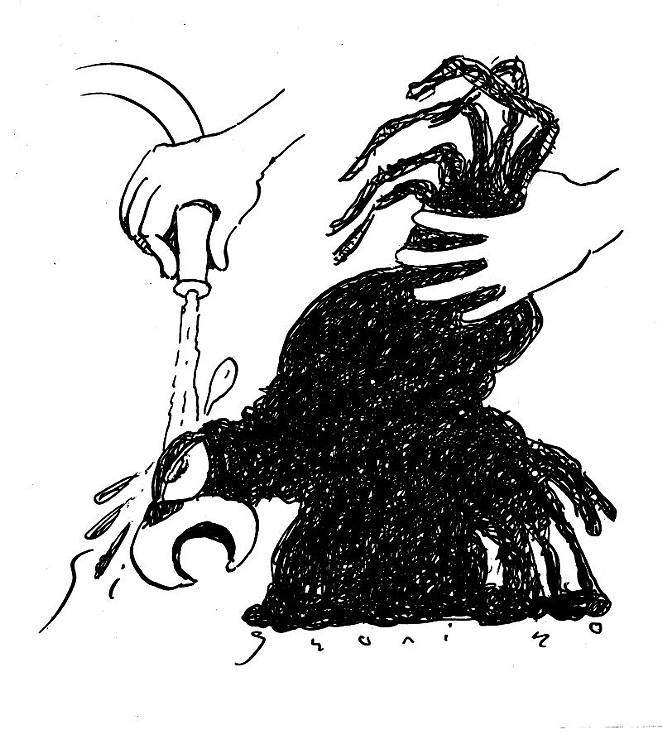When a hurricane blows over an island, as Maria did in Puerto Rico, what happens to the birds? I’m pretty sure a bird can’t just hunker down and wait it out. —J.C.
That depends, J.C—what sorts of birds are we talking here? Migratory? Nonmigratory? Seabirds? Shorebirds? Cavity-nesting birds? It's a little like asking how humans fare during a hurricane.
Broadly we can say it’s not the greatest experience, but beyond that, it’s all variables: whether we live inland or on the coast, in the hills or in the flats; whether we’ve got access to sturdy shelter; etc.
So it is with the feathered set. Mostly this breaks down along species lines, but it can be as simple as where one particular flock calls home. Case in point: the long-suffering Puerto Rican parrot. Here’s a bird whose once-robust populations were reduced in the 20th century, via logging-related habitat loss, to the single digits—a 1975 count put the number of wild individuals at an unlucky 13. With help from conservationists the parrots staged a comeback only to be nearly eradicated again by 1989’s Hurricane Hugo, which flattened the forest where they live.
In the intervening years the parrots managed to bounce back once more, so a lot of fingers were crossed during this latest, particularly brutal hurricane season.
Results varied depending on locale: one flock’s habitat on the eastern end of Puerto Rico was devastated, producing a number of post-storm parrot corpses. The flock in the hilly western region, by contrast? Did just fine.
The bottom line is that these birds don’t really go anywhere when they feel a storm coming—which, by the way, they’re able to do. Birds are sensitive to changes in barometric pressure and temperature, and to some extent they’ll adjust their behavior accordingly, eating in a hurry or seeking shelter before the onset of bad weather.
Some migratory birds will reroute to avoid an approaching hurricane, but there’s no evidence of island species fleeing en masse. Instead, they really do just hunker down and see it through.
With no place to shelter, aquatic birds like pelicans and herons bear the brunt of a storm, accordingly suffering worse mortality rates; some land birds have it easier, though storm-related defoliation will cause problems for (e.g.) your woodpeckers, owls, and parrots—birds that nest in the hollows of fragile older trees.
With a little bad luck, a bird population can take a serious hit. Check out the chimney swifts, a bunch of whom were migrating down the east coast in October 2005 when Hurricane Wilma showed up. The storm carried individual birds as far off as Europe, and at at least 727 flock members turned up dead. We don’t know what fraction of total casualties that represents, but the next spring, chimney swift numbers were down by 50 percent in their Quebec roosting grounds.
Swept off to Europe, you say? That’s one reason it’s tough to track avian mortality in these situations. Hurricanes and tornados can deposit birds far away from areas we might look for them; small birds’ remains might be eaten by scavengers before they can be tallied.
Meanwhile, even the birds that do the best hunkering don’t always stick around for a head count. Again, think what humans often experience following a catastrophic storm: they emerge from the root cellar unscathed, only to discover a radically changed landscape, scarce food and water, etc. Ditto for the birds. Survivors may wander afield looking for food if their usual sources have dried up.
(This yields its own mortality factor—outside familiar neighborhoods, the birds sometimes get shot by humans trying to keep them away.)
In the worst cases their habitats have been destroyed; here too, the severity of this varies by species, with nectar drinkers and seed eaters (hummingbirds, doves, et al) being particularly vulnerable.
That’s relative, anyway, to the insectivores and raptors, not that they’re exactly on easy street. One Caribbean bug-eater of particular concern is the near-endangered Barbuda warbler, at least some of whom made it through the recent storms down there; there’d been worries that the species (pre-storm population: 2,500, tops) might get wiped out altogether.
In the aftermath, conservationists had to scramble to get the birds some food—at the same time everyone on Barbuda was scrambling to deal with damage to 95 percent of the buildings on the island.
Admirable priorities, sure. But stepping up for the warblers was the least we could do, honestly, seeing as we’re the reason they’re having trouble to begin with—there’s really no such thing as a “natural” disaster anymore. As plenty of ornithologists have pointed out, birds have weathered big storms for ages, or not; that’s called natural selection.
It’s people who’ve ratcheted up the environmental pressures: shrinking avian habitats, disrupting food sources, putting in oil pipelines and chemical plants that rupture and leak, and, of course, altering the climate such that more and stronger storms are increasingly inevitable. It’s a good thing, I suppose, that the birds are getting so much practice battening down the hatches—they’re going to need it.


